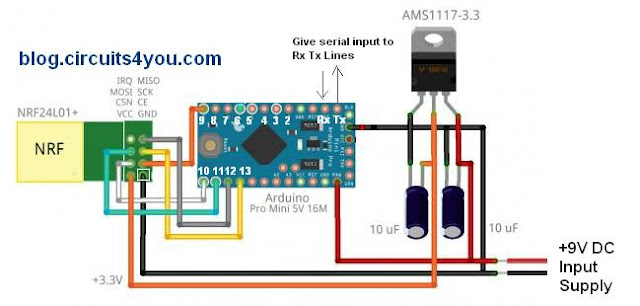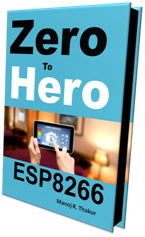This project is very useful in many application where wireless reliable serial communication is required. It give bidirectional communication, You need to have same code in both arduino, no need of separate configuration for receiver or transmitter. It is more advantageous and cost saving than using Xbee, Zegbee Modules.
This circuit is consists of Arduino Pro Mini 3.3V 8MHz and nRF24L01+ RF Module, this make it very low cost and reliable, it can communicate at longer distances when we use nRF24L01+ PA LNA module.
The code is done with most advance possible conditions here I am using custom serial software routine instead of arduino serial to make possible to have 256bytes of serial buffer. arduino have only 64 bytes of serial buffer for longer serial data use of internal buffer causes problems so I made my own serial rutine
Let's look at its advantages nRF24L01+ modules are very cheap and low power consuming, you can power your circuit using 3V battery also, that's why I am using Arduino Pro Mini 3.3V 8MHz, you can use any arduino board, only take care that supply to nRF24L01+ module must be 3.3V, nRF24L01+ can take 5V on its IO lines so no need to have any level conversion circuits.
Applications of this projects are limitless you can use it for your robotic applications, remote sensing, wireless remote control, RC air craft as nRF24L01+ PA LNA module can give open air 1000 meter range.
Components required:
1. nRF24L01+ Quantity 2.
2. Two arduino boards.
Introduction to nRF24L01+:
The nRF24L01+ is a single chip 2.4GHz transceiver with an embedded baseband protocol engine, suitable for ultra low power wireless applications. The nRF24L01+ is designed for operation in the world wide ISM frequency band at 2.400-2.4835GHz.
To design a radio system with the nRF24L01+, you simply need an microcontroller and a few external passive components.
You can operate and configure the nRF24L01+ through a Serial Peripheral Interface (SPI). The register map, which is accessible through the SPI, contains all configuration registers in the nRF24L01+ and is accessible in all operation modes of the chip.
The embedded baseband protocol engine is based on paket communication and supports various modes from manual operation to advanced autonomous protocol operation.
Internal FIFOs ensure a smooth data flow between the radio front end and the system's microcontroller. Enhanced Shock-Burst reduces system cost by handling all the high speed link layer operations.
The radio front end uses GFSK modulation. It has user configurable parameters like frequency channel, output power and air data rate. nRF24L01+ supports an air data rate of 250kbps, 1Mbps and 2Mbps. The high air data rate combined with two power saving modes make the nRF24L01+ very suitable for ultra low power designs.
Step 1: Circuit Connections of nRF24L01+ with Arduino Pro Mini you can use Arduino Uno also with same code and connections

Step 2: Programming
RF24 library is required you can download it from arduino web site
You can modify the program if you want to control your robotics with wireless serial.
At serial send subroutine wireless received data is sent to serial, and when serial data is received it is put into buffer then transmitter through nRF24L01+
Use same code in both arduino boards.
Step 3: Testing of Wireless Serial
1. Open serial terminal of both boards
2. What ever you send from one board serial terminal will appear it in other serial terminal and vice versa.
3. Points to remember Wireless nRF24L01+ module will not work if they are placed very close, at least have 2 to 3 meter distance between them to work properly
4. Check baud rate in serial init routine, I think I am using 19200 BAUD it depends on your board 8MHz or 16MHz
This circuit is consists of Arduino Pro Mini 3.3V 8MHz and nRF24L01+ RF Module, this make it very low cost and reliable, it can communicate at longer distances when we use nRF24L01+ PA LNA module.
The code is done with most advance possible conditions here I am using custom serial software routine instead of arduino serial to make possible to have 256bytes of serial buffer. arduino have only 64 bytes of serial buffer for longer serial data use of internal buffer causes problems so I made my own serial rutine
Let's look at its advantages nRF24L01+ modules are very cheap and low power consuming, you can power your circuit using 3V battery also, that's why I am using Arduino Pro Mini 3.3V 8MHz, you can use any arduino board, only take care that supply to nRF24L01+ module must be 3.3V, nRF24L01+ can take 5V on its IO lines so no need to have any level conversion circuits.
Applications of this projects are limitless you can use it for your robotic applications, remote sensing, wireless remote control, RC air craft as nRF24L01+ PA LNA module can give open air 1000 meter range.
Components required:
1. nRF24L01+ Quantity 2.
2. Two arduino boards.
Introduction to nRF24L01+:
The nRF24L01+ is a single chip 2.4GHz transceiver with an embedded baseband protocol engine, suitable for ultra low power wireless applications. The nRF24L01+ is designed for operation in the world wide ISM frequency band at 2.400-2.4835GHz.
To design a radio system with the nRF24L01+, you simply need an microcontroller and a few external passive components.
You can operate and configure the nRF24L01+ through a Serial Peripheral Interface (SPI). The register map, which is accessible through the SPI, contains all configuration registers in the nRF24L01+ and is accessible in all operation modes of the chip.
The embedded baseband protocol engine is based on paket communication and supports various modes from manual operation to advanced autonomous protocol operation.
Internal FIFOs ensure a smooth data flow between the radio front end and the system's microcontroller. Enhanced Shock-Burst reduces system cost by handling all the high speed link layer operations.
The radio front end uses GFSK modulation. It has user configurable parameters like frequency channel, output power and air data rate. nRF24L01+ supports an air data rate of 250kbps, 1Mbps and 2Mbps. The high air data rate combined with two power saving modes make the nRF24L01+ very suitable for ultra low power designs.
Step 1: Circuit Connections of nRF24L01+ with Arduino Pro Mini you can use Arduino Uno also with same code and connections

Step 2: Programming
RF24 library is required you can download it from arduino web site
You can modify the program if you want to control your robotics with wireless serial.
At serial send subroutine wireless received data is sent to serial, and when serial data is received it is put into buffer then transmitter through nRF24L01+
Use same code in both arduino boards.
//Blog.Circuits4you.com Wireless serial communication //26-Jan-2015 //DO NOT FORGET BAUD RATE SETTINGS FOR 8MHz MINI PRO #include <avr/io.h> #include <avr/interrupt.h> #include <SPI.h> #include "nRF24L01.h" #include "RF24.h" RF24 radio(9,10); const uint64_t pipes[2] = { 0xDEDEDEDEE7LL, 0xDEDEDEDEE9LL }; char SerialBuffer[256] = ""; char RecvPayload[128] = ""; int i,TimeOut=10,dataBufferIndex=0; void setup() { radio.begin(); radio.setDataRate(RF24_250KBPS); radio.setPALevel(RF24_PA_MAX); radio.setChannel(70); radio.enableDynamicPayloads(); radio.setRetries(15,15); radio.setCRCLength(RF24_CRC_16); radio.openWritingPipe(pipes[0]); radio.openReadingPipe(1,pipes[1]); radio.startListening(); USART_Init(); SREG=0x80; delay(500); } void loop() { nRF_receive(); if(TimeOut==0 && dataBufferIndex>0) { serial_receive(); // Send this buffer out to radio } else { TimeOut--; } } void USART_vSendByte(char u8Data) { // Wait if a byte is being transmitted while((UCSR0A & (1<<UDRE0)) == 0); // Transmit data UDR0 = u8Data; } /****************************************************************************************/ /* USART INIT */ /****************************************************************************************/ void USART_Init() { /*Set baud rate */ UBRR0H = 0; UBRR0L = 51; //103 @ 16MHz 51 @ 8MHz //Set double speed enabled UCSR0A |= (1<<U2X0); /*Enable receiver and transmitter */ UCSR0B = (1<<RXEN0)|(1<<TXEN0) | (1<<RXCIE0); /* Set frame format: 8data, 2stop bit */ UCSR0C = (1<<USBS0)|(3<<UCSZ00); } /****************************************************************************************/ /* USART ISR */ /****************************************************************************************/ SIGNAL(USART_RX_vect) { char incomingByte = UDR0; SerialBuffer[dataBufferIndex++]=incomingByte; TimeOut=2000; sei(); return; } /****************************************************************************************/ /* RF Receive */ /****************************************************************************************/ void nRF_receive(void) { int len = 0; if ( radio.available() ) { bool done = false; while ( !done ) { len = radio.getDynamicPayloadSize(); done = radio.read(&RecvPayload,len); delay(5); } RecvPayload[len] = 0; // null terminate string for(i=0;i<len;i++) { USART_vSendByte(RecvPayload[i]); } RecvPayload[0] = 0; // Clear the buffers } } void serial_receive(void)
{
char SendPayLoad[32];
// swap TX & Rx addr for writing
radio.openWritingPipe(pipes[1]);
radio.openReadingPipe(0,pipes[0]);
radio.stopListening();
if(dataBufferIndex<31) //as nRF24L02 have only 32 byte of buffer to send more bytes it need to be splitted
{
bool ok = radio.write(&SerialBuffer,dataBufferIndex);
}
else
{
for(i=0;i<30;i++)
{
SendPayLoad[i]=SerialBuffer[i];
}
bool ok = radio.write(&SendPayLoad,30); //First 30 Bytes are sent
if((dataBufferIndex-30)<31) //If remainging bytes are less than 31
{
for(i=0;i<(dataBufferIndex-30);i++)
{
SendPayLoad[i]=SerialBuffer[i+30];
}
bool ok = radio.write(&SendPayLoad,(dataBufferIndex-30)); //Remaining Bytes are sent
}
else //Remaining bytes are more than 31 i.e total is greater than 60
{
for(i=0;i<30;i++)
{
SendPayLoad[i]=SerialBuffer[i+30];
}
bool ok = radio.write(&SendPayLoad,30); //60 Bytes are sent
if((dataBufferIndex-60)<31) //If remainging bytes are less than 31
{
for(i=0;i<(dataBufferIndex-30);i++)
{
SendPayLoad[i]=SerialBuffer[i+60];
}
bool ok = radio.write(&SendPayLoad,(dataBufferIndex-60)); //Remaining Bytes are sent
}
}
}
// restore TX & Rx addr for reading radio.openWritingPipe(pipes[0]); radio.openReadingPipe(1,pipes[1]); radio.startListening(); SerialBuffer[0] = 0; // Clear the buffers dataBufferIndex = 0; } // end serial_receive() #ifndef min #define min(a,b) ( (a) < (b) ? (a) : (b) ) #endif void mid(const char *src, size_t start, size_t length, char *dst, size_t dstlen) { size_t len = min( dstlen - 1, length); strncpy(dst, src + start, len); // zero terminate because strncpy() didn't ? if(len < length) dst[dstlen-1] = 0; }
Step 3: Testing of Wireless Serial
1. Open serial terminal of both boards
2. What ever you send from one board serial terminal will appear it in other serial terminal and vice versa.
3. Points to remember Wireless nRF24L01+ module will not work if they are placed very close, at least have 2 to 3 meter distance between them to work properly
4. Check baud rate in serial init routine, I think I am using 19200 BAUD it depends on your board 8MHz or 16MHz





ReplyDelete'UCSR0A' WASE NOT DECLARED IN THIS SCOPE
Hi,
ReplyDeletewith the above post I found exactly what I need. With my project I like to read 4 or 5 sensors on two different locations (!) and at the same time I need to controll a DC motor on one of the locations of the sensors while collecting data. My questions are twofold:
1. hardware
if I use a 3.3V UNO or mini I would not need the AMS1117-3.3, right?
A 8MHz unit rather than 16MHz would work as well, e.g. a ProMini ATmega 328P 3,3V?
2. code
the bidirectional communication in my project via nRF24L01+ modules shall be in a way that the sensors continuously deliver data. Intermittent I may need to send control signals from "the receiving arduino", which is attached to a PC to one of the other arduinos to control the speed and direction of a DC motor. Does the code provide for such a situation, i.e. switch to send mode upon request on the arduino by the PC?
In your post you write that the code shall be used in both arduino boards. Would that work the same with 3 (or even more) boards? Unfortunately I'm not really advanced with the coding but the rationale tells me if it's working with two it shall work also with three or more bords simultaneously. Hope I'm not on the wrong track.
How resp. where do I insert the code snippet to read the sensors on various pins into your code? I need to display the sensor data on the PC on different virtual gauges!
Tanks for your reply
example:99: error: void value not ignored as it ought to be
ReplyDeletedone = radio.read(&RecvPayload,len);
^
exit status 1
void value not ignored as it ought to be